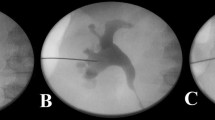Abstract
Recently, an increasing number of investigators have debated the wide rule of the puncture to renal papilla in PCNL. We evaluated the effect of renal papillary and nonpapillary puncture on bleeding in an in vitro porcine kidney experience, with the aim of determining the safe puncture sites of collecting system in PCNL. A total of 70 fresh porcine kidneys were selected and subjected to nephrostomy. We performed a puncture through a renal papilla, infundibulum, renal column, or minor calyceal neck (including the front, back, up, and down). The primary outcome was the amount of bleeding. The results showed that the papillary puncture group yielded minimal bleeding (1.59 ± 1.01 ml/min) compared with the infundibular puncture group (6.25 ± 4.46 ml/min, P < .001), renal column puncture group (4.24 ± 3.79 ml/min, P = 0.001), and minor calyceal neck puncture group (2.27 ± 1.35 ml/min, P = 0.011). However, after stratifying by orientation, the up (1.75 ± 0.80 ml/min, P = 0.501) or down (1.77 ± 0.72 ml/min, P = 0.437) minor calyceal neck puncture group and papillary puncture group yielded comparable bleeding. In summary, nonpapillary puncture must be carefully considered. Infundibular and renal column punctures were inferior to papillary puncture, and up or down minor calyceal neck puncture may be a prudent choice in specific situations.

Similar content being viewed by others
Availability of data and materials
Data are available with permission from the corresponding author.
Code availability
Not applicable.
Abbreviations
- PCNL:
-
Percutaneous nephrolithotomy
References
Turk C, Petrik A, Sarica K, Seitz C, Skolarikos A, Straub M et al (2016) EAU guidelines on interventional treatment for urolithiasis. Eur Urol 69:475–482. https://doi.org/10.1016/j.eururo.2015.07.041
Guler A, Erbin A, Ucpinar B, Savun M, Sarilar O, Akbulut MF (2019) Comparison of miniaturized percutaneous nephrolithotomy and standard percutaneous nephrolithotomy for the treatment of large kidney stones: a randomized prospective study. Urolithiasis 47:289–295. https://doi.org/10.1007/s00240-018-1061-y
Bagetti Filho HJS, Pereira-Sampaio MA, Favorito LA, Sampaio FJB (2008) Pig kidney: anatomical relationships between the renal venous arrangement and the kidney collecting system. J Urol 179:1627–1630. https://doi.org/10.1016/j.juro.2007.11.040
Sampaio FJ, Aragao AH (1990) Anatomical relationship between the intrarenal arteries and the kidney collecting system. J Urol 143:679–681. https://doi.org/10.1016/s0022-5347(17)40056-5
Sampaio FJ, Zanier JF, Aragão AH, Favorito LA (1992) Intrarenal access: 3-dimensional anatomical study. J Urol 148:1769
Kyriazis I, Kallidonis P, Vasilas M, Panagopoulos V, Kamal W, Liatsikos E (2017) Challenging the wisdom of puncture at the calyceal fornix in percutaneous nephrolithotripsy: feasibility and safety study with 137 patients operated via a non-calyceal percutaneous track. World J Urol 35:795–801. https://doi.org/10.1007/s00345-016-1919-y
Tahra A, Sobay R, Bindayi A, Suceken FY, Kucuk EV (2020) Papillary vs non-papillary access during percutaneous nephrolithotomy: retrospective, match-paired case-control study. Arch Ital Urol Androl 92:50–52. https://doi.org/10.4081/aiua.2020.1.50
Kallidonis P, Vagionis A, Vrettos T, Adamou K, Pagonis K, Ntasiotis P et al (2021) Non papillary mini-percutaneous nephrolithotomy: early experience. World J Urol 39:1241–1246. https://doi.org/10.1007/s00345-020-03267-z
Kallidonis P, Vagionis A, Lattarulo M, Adamou C, Tsaturyan A, Liourdi D et al (2021) Non-papillary percutaneous nephrolithotomy for treatment of staghorn stones. Minerva Urol Nephrol 73:649–654. https://doi.org/10.23736/S2724-6051.20.04124-7
Campobasso D, Ferretti S, Frattini A (2019) Papillary puncture: still a good practice. World J Urol 37:573–574. https://doi.org/10.1007/s00345-018-2527-9
Alotaibi KM (2020) Retrograde nephrostomy access for percutaneous nephrolithotomy: a simple and safe technique. Urolithiasis 48:175–181. https://doi.org/10.1007/s00240-019-01135-z
Seitz C, Desai M, Häcker A, Hakenberg OW, Liatsikos E, Nagele U et al (2012) Incidence, prevention, and management of complications following percutaneous nephrolitholapaxy. Eur Urol 61:146–158. https://doi.org/10.1016/j.eururo.2011.09.016
Wollin DA, Preminger GM (2018) Percutaneous nephrolithotomy: complications and how to deal with them. Urolithiasis 46:87–97. https://doi.org/10.1007/s00240-017-1022-x
Pereira-Sampaio MA, Favorito LA, Sampaio FJ (2004) Pig kidney: anatomical relationships between the intrarenal arteries and the kidney collecting system. Applied study for urological research and surgical training. J Urol 172:2077–2081. https://doi.org/10.1097/01.ju.0000138085.19352.b5
Pereira-Sampaio M, Favorito LA, Henry R, Sampaio FJ (2007) Proportional analysis of pig kidney arterial segments: differences from the human kidney. J Endourol 21:784–788. https://doi.org/10.1089/end.2006.0318
Elsheemy MS, Elmarakbi AA, Hytham M, Ibrahim H, Khadgi S, Al-Kandari AM (2019) Mini vs standard percutaneous nephrolithotomy for renal stones: a comparative study. Urolithiasis 47:207–214. https://doi.org/10.1007/s00240-018-1055-9
Acknowledgements
The authors thank Mrs Zefang Guo, a member of the staff of Chunran Food Co., Ltd, Hefei. She provided us with pig kidneys. This study was supported by the National Natural Science Foundation of China (82070724) and the Natural Science Foundation of Anhui Province (1908085MH246).
Funding
This work was supported by the National Natural Science Foundation of China (82070724) and the Natural Science Foundation of Anhui Province (1908085MH246).
Author information
Authors and Affiliations
Contributions
All authors contributed to the study conception and design. Material preparation, data collection, and analysis were performed by HB, WM, SZ, QH, and HZ. The first draft of the manuscript was written by HB and all authors commented on previous versions of the manuscript. All authors read and approved the final manuscript.
Corresponding author
Ethics declarations
Conflict of interest
The authors declare that they have no conflict of interest.
Ethics approval
All animal experiments were conducted following the national guidelines and the relevant national laws on the protection of animals, and were approved by the Ethics Committee of Anhui Medical University (No. LLSC20211053).
Consent to participate
Not applicable.
Consent for publication
Not applicable.
Additional information
Publisher's Note
Springer Nature remains neutral with regard to jurisdictional claims in published maps and institutional affiliations.
Rights and permissions
About this article
Cite this article
Hou, B., Wang, M., Song, Z. et al. Renal puncture access via a nonpapillary track in percutaneous nephrolithotomy: an in vitro porcine kidney experience. Urolithiasis 50, 357–360 (2022). https://doi.org/10.1007/s00240-022-01302-9
Received:
Accepted:
Published:
Issue Date:
DOI: https://doi.org/10.1007/s00240-022-01302-9




